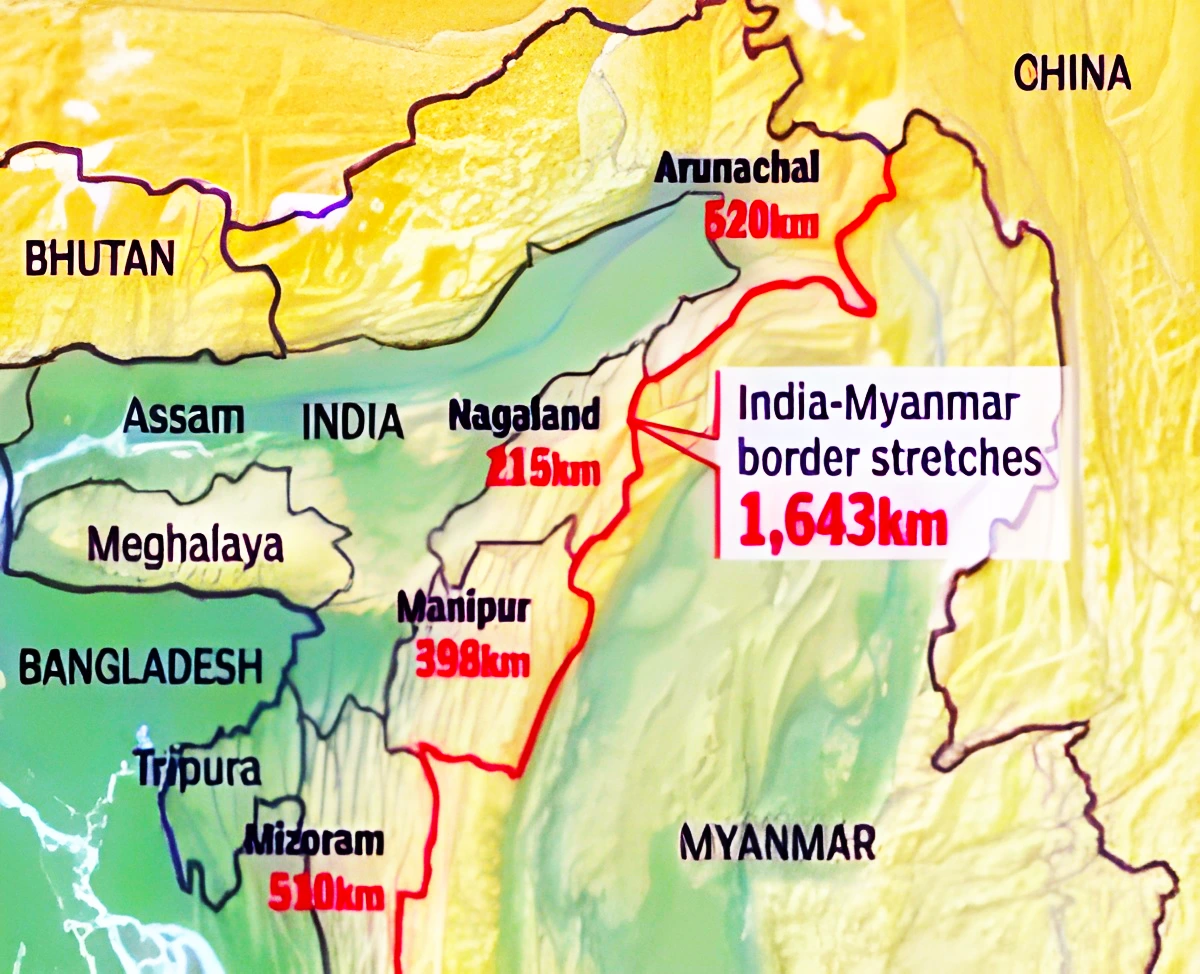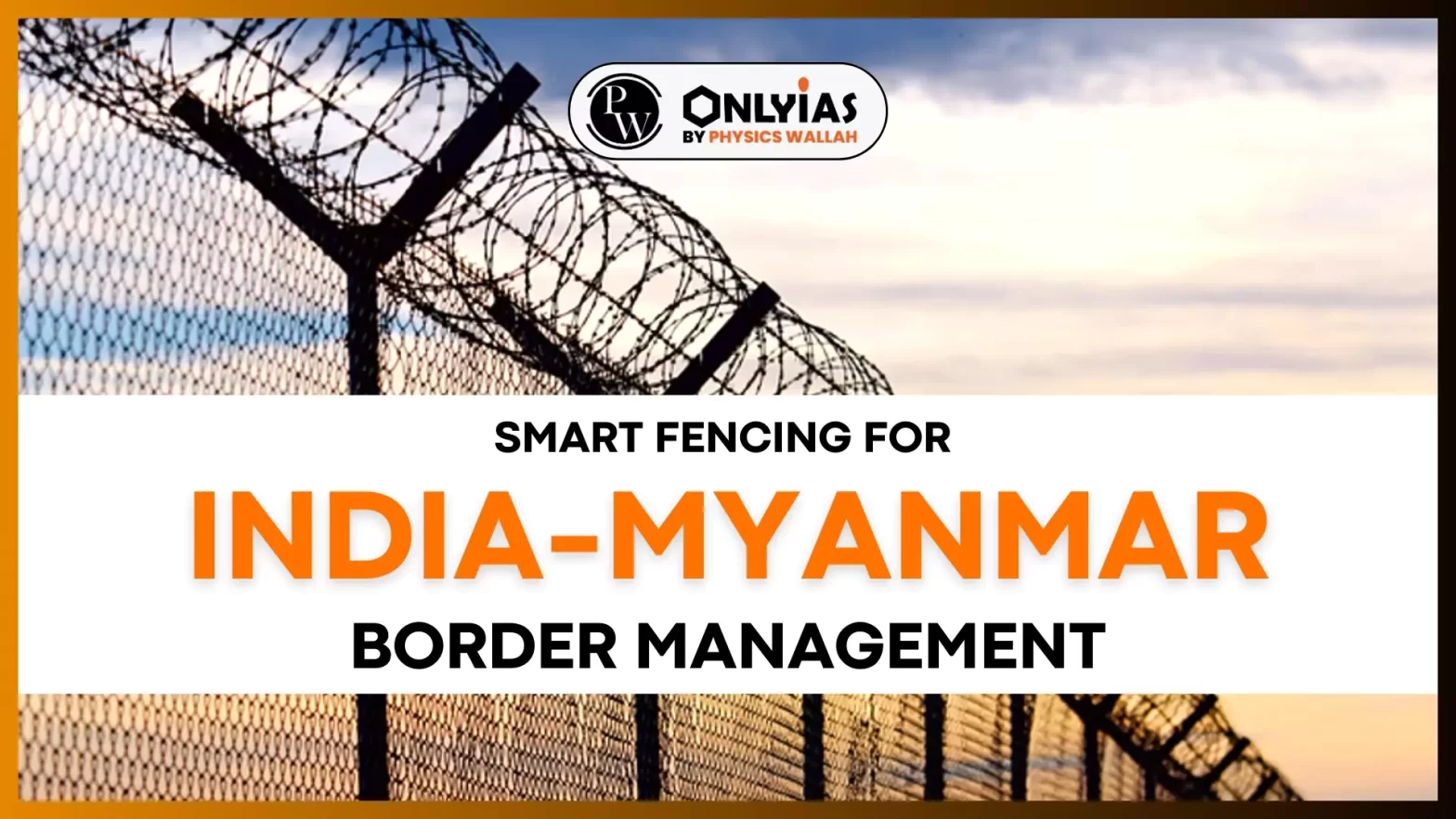Context: The government is set to issue orders for smart fencing for an additional 300 kilometres out of the 1,643 km of India-Myanmar border, running along Arunachal Pradesh, Nagaland, Manipur and Mizoram.
Why is India Building Smart Fencing Along India-Myanmar Border?
- Background: After the conflicts in May 2023 in Manipur, the Centre started a project for fencing the border.
- The development follows the completion of a 10-kilometer pilot project last year and smart fencing order for an additional 80 kilometres, bringing the total length of smart fencing to 390 km.
- Ethnic Conflicts: The decision has been made in the background of ongoing ethnic conflicts and the illegal migration of Chin-Kuki nationals from Myanmar.
- According to government officials, the remaining border will likely be completed in the next four and half years.
- Illicit Activities: Large-scale smuggling of products, narcotics, weapons, and ammunition has occurred along the porous border between India and Myanmar.
- End of FMR: Following the installation of the smart fencing, the free movement regime (FMR) along the border between India and Myanmar will be stopped..
- The FMR is increasingly being looked at as a threat to national security on the grounds that it facilitates undeterred border crossing by both insurgents and illegal migrants.
About Smart Fence Project
- It entails deploying laser-activated fences and technology-enabled barriers to plug vulnerable gaps along borders.
- Smart fencing uses a number of devices for surveillance, communication and data storage.
- Sensors like thermal imager, underground sensors, fiber optical sensors, radar and sonar will be mounted on different platforms like aerostat, tower and poles as part of the smart fence.
- It provides for round-the-clock surveillance on the border and different weather conditions.
- The initiative is part of the comprehensive integrated border management system (CIBMS).
|
What is Border Management?

- The primary goals of border management include securing the nation’s borders against hostile interests and implementing systems capable of intercepting such elements, all while facilitating legitimate trade and commerce.
About India-Myanmar Border
- Boundary with Indian States: India and Myanmar share a border close to 1600 kms constituting international boundaries for four northeastern states of India- Mizoram, Nagaland, Manipur and Arunachal Pradesh.
- Vulnerable India Myanmar Terrain: The border is characterized by high mountains, deep river channels, and dense forests, posing difficulties for the construction of transportation and communication infrastructure.
- Consequently, the border region remains sparsely populated with limited economic development.
India-Myanmar Border: Issues & Challenges
- Illegal Immigrants Along Porous Border: FMR has facilitated inward passage for illegal migrants who have sought refuge across the border.There is an increase in the entry of illegal migrants after the recent military coup in Myanmar.
- According to the United Nations High Commission for Refugees (UNHCR), an estimated 22,000 refugees have entered India from Myanmar since February 2021.
- Apart from creating a demographic imbalance, the migrants are viewed as a key cause of disturbances in the law and order situation.
- Drug Abuse from Golden triangle: Myanmar is the part of Golden Triangle region employing heavily-militarised and largely-lawless territory the producers and traffickers operate located at the meeting point of the borders of Thailand, Laos and Myanmar.
- The porous nature of the border has facilitated the flow of drugs from Myanmar to India.
- Myanmar is the second-largest producer of opium with the Kachin state of Myanmar being the largest producers of drugs in Myanmar with which India shares the border.
- Interlinkage Between Drug Traffickers and Insurgent Groups: Drugs from India’s Northeastern states acts as a financial source for the insurgent groups of the Northeast.
- Most of the insurgent groups receive financial assistance from drug cartels that mainly operate outside of the Indian territory.
- Data from the Manipur Chief Minister’s Office show that 500 cases were registered and 625 individuals were arrested under the Narcotic Drugs and Psychotropic Substances (NDPS) Act in Manipur in 2022.
- Smuggling of narcotics and illegal arms: The trafficking of Small Arms and Light Weapons (SALW) has linkages with the functioning of the illicit drug economy.
- Drugs are used as currencies for the purchase of Small Arms and Light weapons by insurgents or terror groups.
- According to the report, Rakhine militants as well as Indian insurgents with training camps in Myanmar’s Sagaing region are the main buyers of illegal arms.
- Human Trafficking: The instability, turmoil, and internal power struggles within Myanmar gave rise to criminal syndicates exploiting vulnerable individuals for illicit gains.
- According to the Minister of State for External Affairs, more than 400 Indian men are stuck in fraudulent IT jobs in Myanmar due to the promise of fake IT occupations.
- Children across the border are used as couriers for transporting heroin and methamphetamine substances, along with monitoring the Mizoram-Myanmar border.
- Ethnic Conflicts: The ongoing ethnic conflict between the Meiteis and Kukis in Manipur is due to illegal migration of tribal Kuki-Chin peoples from Myanmar into India.
- The Meiteis accuse the illegal migrants and the alleged “narco-terror network” along the Indo-Myanmar Border (IMB) of instigating trouble in the state.
- In contrast, the Kukis blame the Meiteis alleging the use of this situation as a pretext for “ethnic cleansing.”
- Exploitation of Cross Border Ethnic linkages: Through the 1967 boundary agreement, India-Myanmar boundary is superimposed on the socio-cultural landscape of the borderland, dividing several tribes and forcing them to reside as citizens of different countries.
- These tribes, having strong cross-border ethnic linkages are often exploited by the insurgents to find shelter across the border.
About Free Movement Regime (FMR)
- Under the Free Movement Regime (FMR), individuals belonging to hill tribes, whether they are Indian or Myanmar citizens residing within 16 km on either side of the India-Myanmar border, can cross the border by presenting a border pass.
- The border pass is issued by the competent authority and is valid for one year.
|
Government Interventions for India-Myanmar Border Management
- Border Infrastructure and Management (BIM) Scheme: A Central Sector Scheme comprising projects aimed at infrastructure development of India’s international borders.
- Comprehensive Integrated Border Management System: It aims to improve situational awareness to facilitate prompt and quick response to emerging situations along the India-Pakistan Border (IPB) and India-Bangladesh Border (IBB).
- Border Area Development Programme (BADP): It aims to meet the special developmental needs and well-being of the people living in remote and inaccessible areas situated near the International Boundary (IB).
- It provides the border areas with essential infrastructure by convergence of BADP/other Central/States/UT/Local Schemes.
- Vibrant Villages Programme (VVP): It focuses on comprehensive development of the select villages in 46 blocks in 19 districts of northern border in the States of Arunachal Pradesh, Himachal Pradesh, Sikkim, Uttarakhand and UT of Ladakh.
Way Forward for India-Myanmar Border Management
- Round the Clock Border Guarding: There is a need to deploy a regular Border Guarding force for continuous vigilance of India – Myanmar border.
- Border guarding entails round the clock and continuous physical domination of the border to plug gaps, prevent infiltration, drugs and arms smuggling, illegal migration, etc. to strengthen the security of the border.
- Creating Border Infrastructure: Creation of adequate infrastructure along the border is needed. It includes the creation of composite Border Observation Posts (BOPs), Border Road, and Obstacle System.
- Separation of Patrolling and security functions: The Assam Rifles(AR) is in charge of border patrol as well as ensuring border security.
- Thus, a sizable portion of its battalions are engaged in counterinsurgency activities, which makes border security more difficult. Thus, the two functions need to be completely separated.
- Moreover, the battalions guarding the border need to be stationed right at the border itself, unlike at present where they operate from well inside Indian territory.
- A force other than AR may be deployed exclusively for border guarding. AR with deep historical connections, knowledge of the terrain, culture and ethos of NE and vast experience of operating against insurgents and separatists in that area will be more effective in this role.
- Strengthening of Legal frameworks: Improved coordination between India and Myanmar’s law enforcement agencies is essential to combat trafficking effectively.
- Joint operations and intelligence sharing can help intercept traffickers and rescue victims.
- Although the Memorandum of Understanding (MoU) was signed between India and Myanmar in 2019 to enhance bilateral cooperation on the prevention, rescue, recovery, and repatriation of persons who have been trafficked, the terms have not been upheld.
- Although both countries have passed legislation making human trafficking illegal and protecting victims, as well as ratifying international agreements against the practice, the present political unrest impedes appropriate and timely action to guarantee the security and safety of trafficked individuals.
- Rehabilitation: Alongside rescue efforts, rehabilitation and support to the victims with proper psychological evaluation and treatment are needed to help them reintegrate into society and rebuild their lives.
- Addressing the complex issue requires concerted efforts from both India and Myanmar, along with international cooperation, to ensure the safety and well-being of the victims.
- Increased Collaboration: Enhancing collaboration between border control agencies and establishing direct communication channels can serve as a potent strategy to combat trafficking in persons and foster cross-border and regional cooperation.
- Awareness Creation: Border guarding forces need to promote a sense of security amongst the border population by carrying out tactical operations as well as identifying and projecting problems of the border population to concerned authorities.
- Strengthening of Bilateral Institutional Mechanisms: India has constituted institutional mechanisms with Myanmar which need to be revised with changing dynamics and increasing challenges at the India-Myanmar border.
Also Read: Centre Signs Peace Pact With ULFA Faction
Conclusion:
The implementation of smart fencing technology along the India-Myanmar border reflects a strategic response to address security challenges, ethnic conflicts, and illicit activities.
![]() 3 Jan 2024
3 Jan 2024


